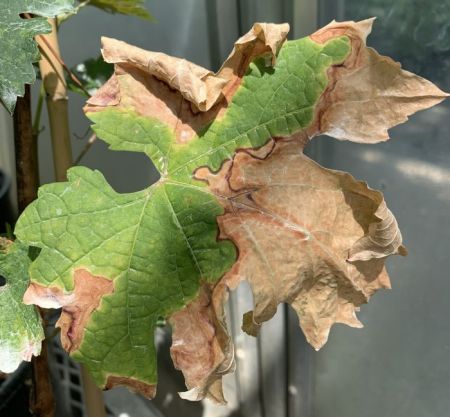Xylella
Xylella fastidiosa and Xylella taiwanensis are bacterial pathogens which are exotic to Australia. Xylella fastidiosa is present in the Americas, Europe and parts of the Middle East whilst Xylella taiwanensis is only present in Taiwan. Both species of Xylella are a serious threat to agriculture, the environment and the economy.
Xylella lives in the water conducting systems (xylem) of plants and is spread by infected plant material and xylem-feeding insects such as leafhoppers, sharpshooters and spittlebugs. The glassy winged sharpshooter, a key vector for transmission, is also exotic to Australia but there are many native Australian insects which could potentially vector Xylella.
Xylella infects over 600 plant species including native, commercial and ornamental plants. Diseases caused by Xylella infections (known under different names depending on the host) include, but are not limited to:
- Pierce’s disease of grapevines
- citrus variegated chlorosis
- olive quick decline syndrome
- phony peach disease
- almond leaf scorch
- pear leaf scorch
- cherry leaf scorch
- almond leaf scorch
- avocado leaf scorch
Xylella is not present in Australia but remains one of the most significant emerging plant disease threats worldwide. It was recognised as Australia’s top National Priority Plant Pest in 2019 and remains the number 1 priority plant pest. This decision is reflective of the potential economic and environmental impacts that Xylella could have in Australia.
Symptoms of Xylella
Xylella symptoms can vary between hosts and some hosts may not show symptoms at all (asymptomatic), especially during the first two years of infection. Symptoms can easily be confused with water stress, frost and herbicide damage but include:
- signs of water stress, the most common being leaf scorch, premature loss of leaves and dieback
- yellowing leaves, reduced fruit size and fruit failing to ripen
- abnormally long retention of flowers and leaves in some hosts such as peach
- progressive weakening of the plant/tree (sometimes over several seasons). Many susceptible hosts will eventually die.
Xylella symptoms

Figure 1. Grapevine leaf infected with Xylella fastidiosa – Pierce’s Disease. Image source: Pragya Kant (Agriculture Victoria Research)

Figure 2. Citrus leaves infected with Xylella fastidiosa – citrus variegated chlorosis. Image source: Pragya Kant (Agriculture Victoria Research)

Figure 3. Olive leaf infected with Xylella fastidiosa – olive quick decline syndrome. Image source: Pragya Kant (Agriculture Victoria Research)
For more Xylella images on a variety of host plants, visit European and Mediterranean Plant Protection Organisation.
Detection and prevention measures
There is currently no cure available for Xylella. Because of this, early detection and public reporting is critical. Agriculture Victoria conducts active surveillance for Xylella and its vectors under the National Plant Health Surveillance Program (NPHSP) and regularly responds to reports of suspect plant diseases and conducts exclusion diagnostics on plants with symptoms.
To protect your property, maintain best practice on-farm biosecurity standards, ensure propagation material is purchased from reputable suppliers and regularly check your plants for symptoms. If you spot any unusual symptoms or suspect Xylella is present on your property, please submit a report online using the online reporting form below.
Reporting an unusual plant insect pest or disease
Report any unusual plant pest or disease immediately using our online reporting form or by calling the Exotic Plant Pest Hotline on 1800 084 881. Early reporting increases the chance of effective control and eradication.
Please take multiple good quality photos of the pests or damage to include in your report where possible, as this is essential for rapid pest and disease diagnosis and response.
Your report will be responded to by an experienced staff member, who may seek more information about the detection and explain next steps.
Report online